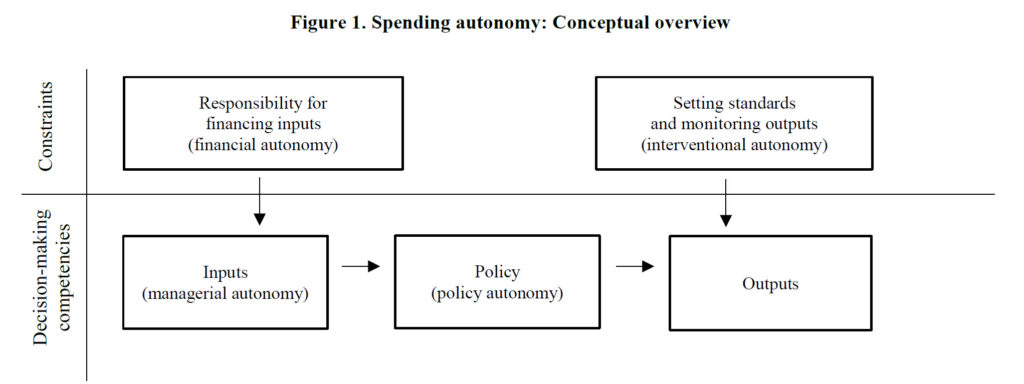
Countries differ with respect to the functions or competencies assigned to subnational governments, and with respect to the share of public spending being done by subnational governments. In addition, however, countries may differ with respect to the degree of autonomy that subnational governments have over their functional mandates and expenditure responsibilities. This latter topic—understanding the decision-making power of subnational governments—have received limited attention in the literature.
In exploring subnational decision-making power and spending autonomy, A conceptual distinction can be made between two kinds of subnational autonomy: (i) autonomy as having own decision-making within the realm of exercising its competencies, and (ii) autonomy as being shielded from central governmental constraints on actual decision-making.

The figure above suggests that further distinctions can be made within these two dimensions of autonomy. More specifically, the autonomy as decision-making competencies consists of two dimensions: managerial (input) autonomy and policy autonomy. Managerial autonomy refers to the extent to which sub-central governments have decision-making competencies delegated from the center regarding the choice and use of inputs. Policy autonomy, on the other hand, indicates to what extent the sub-central governments can take decisions about processes and procedures they have to produce goods or services; the policy instruments used to implement policy and the quantity and quality of the goods or services to be produced; and the target groups and societal objectives and outcomes to
be reached by the policy.
Exploring the extent of functional autonomy and developing spending autonomy indicators for sub-national governments in the real world is not as straightforward as it may seem. In contrast to tax autonomy indicators, the spending side of the budget comprises a wide range of policy areas. Furthermore, whereas ‘autonomy’ in terms of taxation boils down to the ability of sub-national governments to set tax rates, tax bases, or both, ‘autonomy’ over spending is more multifaceted. To put it simply, deciding about the delivery of public goods and services is not only limited to making choices over the size of the budget.
A recent study by Jarosław Kantorowicz and Bob Jurriaan van Grieken on Spending Autonomy of Sub-central Governments: Conceptualization and Measurement has two broad goals: (i) to bring conceptual clarity about spending autonomy and (ii) to measure the extent of countries’ spending autonomy across five policy areas (education, old-age care, transport, housing and health care). The policy areas were chosen given their importance in SNGs expenditure.
This study departs from capturing the spending autonomy by measuring the spending shares of SNGs, instead it examines the institutional (organizational) and decision-making aspects of autonomy as related to the spending part of the budget. A questionnaire was distributed to countries in early 2018, with seventeen OECD countries and four partner countries responding to the survey in full. Several other countries provided partial answers, including Denmark, South Africa, Germany and Belgium. Subsequently, overall spending autonomy of sub-central governments based on five policy areas (education, old-age care, housing, transport and health care) was devised and measured.
The advantage of newly created indicator lies in the fact that, as compared to other measures of autonomy of sub-central governments, the newly proposed measure goes much more in-depth in capturing the spending side of subcentral governments’ autonomy. In that way, this measure constitutes a valuable addition and complementarity to existing measures, which cover other aspects of autonomy of SNGs, such as, for instance, the OECD tax autonomy index of state and local governments. Likewise, newly proposed indicator enables comparisons of autonomy at various governmental levels, most notably at regional/state and local levels of governments.
The main results of this study can be summarized as follows:
• There is substantial variation in the degree of SNG spending autonomy across countries in all policy sectors. There seem to be also varying patterns of how different dimensions of autonomy are combined. Whilst on average SNGs have low scores on policy autonomy, they have much more leeway in deciding on inputs (managerial autonomy). Financial (budgetary) and interventional (output) autonomy fall somewhere in between managerial and policy autonomy. Depending on the analyzed sector, they are closer to either managerial or policy autonomy.
• Based on the information from the five policy sectors, the composite indicator of spending autonomy was created by employing the random weights technique and two latent variable approaches (country-product-dummy and Bayesian factor analysis). The results indicate that the highest scores of overall spending autonomy are observed in Canada, Switzerland, Belgium and Finland. In contrast, Luxembourg, Ireland, Israel, Slovenia, Iceland and Greece are ranked the lowest in terms of spending autonomy of sub-central governments.
• The composite indicator of spending autonomy positively correlates with other measurements of autonomy of sub-central level governments. Particularly, the analysis observes high correlations between the newly created indicators of spending autonomy of sub-central governments and the regional authority index (RAI) by Hooghe et al. (2016) as well as the constitutional spending power indicator by Blöchliger and Kantorowicz (2015). This corroborates the validity of the newly created indicator.
Read the background paper on the OECD website:
Spending Autonomy of Sub-central Governments: Conceptualization and Measurement (Jarosław Kantorowicz and Bob Jurriaan van Grieken, 2019)




